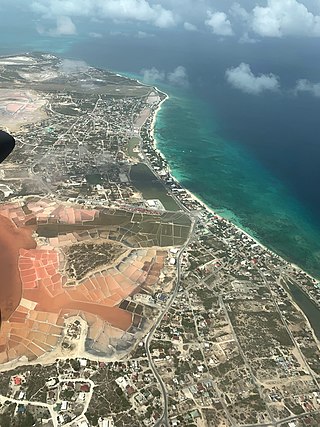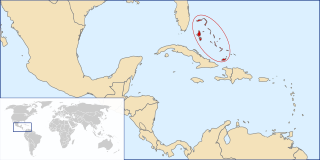
The Turks and Caicos Islands are a British Overseas Territory consisting of the larger Caicos Islands and smaller Turks Islands, two groups of tropical islands in the Lucayan Archipelago of the Atlantic Ocean and northern West Indies. They are known primarily for tourism and as an offshore financial centre. The resident population in 2023 was estimated by The World Factbook at 59,367, making it the third-largest of the British overseas territories by population. However, according to a Department of Statistics estimate in 2022, the population was 47,720.

Before European colonization, the Turks and Caicos Islands were inhabited by Taíno and Lucayan peoples. The first recorded European sighting of the islands now known as the Turks and Caicos occurred in 1512. In the subsequent centuries, the islands were claimed by several European powers with the British Empire eventually gaining control. For many years the islands were governed indirectly through Bermuda, the Bahamas, and Jamaica. When the Bahamas gained independence in 1973, the islands received their own governor, and have remained a separate autonomous British Overseas Territory since. In August 2009, the United Kingdom suspended the Turks and Caicos Islands' self-government following allegations of ministerial corruption. Home rule was restored in the islands after the November 2012 elections.

Grand Turk is an island in the Turks and Caicos Islands, a British Overseas Territory, tropical islands in the Lucayan Archipelago of the Atlantic Ocean and northern West Indies. It is the largest island in the Turks Islands with 18 km2 (6.9 sq mi). Grand Turk contains the territory's capital, Cockburn Town, and the JAGS McCartney International Airport. The island is the administrative, historic, cultural and financial centre of the territory and has the second-largest population of the islands at approximately 4,831 people in 2012.

Mayaguana is the easternmost island and district of The Bahamas. Its population was 277 in the 2010 census. It has an area of about 280 km2 (110 sq mi).

The Turks and Caicos rock iguana is a species of lizard endemic to the Turks and Caicos islands. This small iguana can reach 30 in (76 cm) and becomes mature at seven years and may live for twenty. A single clutch of up to nine eggs is laid each year, and these take three months to hatch. This iguana is mostly herbivorous, but supplements this by adding some animal matter to its diet.

Providenciales is an island in the northwest Caicos Islands, part of the Turks and Caicos Islands, a British Overseas Territory. The island has an area of 98 km2 (38 sq mi) and a 2012 Census population of 23,769. Providenciales is the third largest island in the Turks and Caicos in area, and is home to a large majority of the population of the Turks and Caicos Islands.

South Caicos is the seventh-largest island in the Turks and Caicos archipelago, with a land area of 21.2 square kilometres. South Caicos is known for excellent fishing, both deep-sea and bone fishing, and scuba diving. South Caicos was formerly a salt exporter, the island still hosts a network of salt pans as a reminder of the industry. Today, the island's main income is derived from small-scale commercial fishing.

JAGS McCartney International Airport, also known as Grand Turk International Airport, is an airport located 1 mile (1.6 km) south of Cockburn Town on Grand Turk Island in the Turks and Caicos Islands, an overseas territory of the United Kingdom. It is the second largest airport in the territory, after Providenciales International Airport.

The Turks and Caicos Islands are divided into five administrative districts, and the Island of Grand Turk; four of these are headed by District Commissioners, and Providenciales District is run by the Permanent Secretary of the Office of the Premier in Providenciales. The Island of Grand Turk is directly administered by the TCI Government.
Tropidophis greenwayi is a nonvenomous dwarf boa species endemic to the Caicos Islands. Two subspecies are currently recognized, including the nominate subspecies described here.
Cyclura carinata bartschi, commonly known as Bartsch's iguana or the Booby Cay iguana, is a subspecies of lizard in the family Iguanidae. The subspecies is endemic to a single cay, Booby Cay, in The Bahamas.

The current flag of the Turks and Caicos Islands was adopted on 7 November 1968, and modified in 1999. Prior to this, the islands had several different flags either proposed or utilised.

The following is an alphabetical list of topics related to the British Overseas Territory of the Turks and Caicos Islands.

The following is an alphabetical list of topics related to the Commonwealth of The Bahamas.
Chub Cay is an island in the Berry Islands chain of the Bahamas. It has a population of 46.
Caicos Express Airways is a passenger airline based in the Turks and Caicos Islands. The airline began charter flights in 2007 followed by scheduled services in 2011 from its hub at Providenciales, Turks & Caicos, to multiple domestic destinations. In December 2014, Caicos Express Airways began offering international flights to Haiti.
Aristelliger hechti, known commonly as Hecht's Caribbean gecko or the Caicos gecko, is a species of lizard in the family Sphaerodactylidae. The species is endemic to the Caicos Islands.
Torch Cay is a privately owned island located east of Little Exuma at the southernmost point of the Exuma island chain. This member's only private island is 707 acres in size, making it the largest private island in the Bahamas. Torch Cay derives its name from the white torch tree and found amongst the land’s rare and lush vegetation. The island is home to Torch Cay Airport, the only known airport on a private island worldwide where you can land and clear customs with an ultra-long-range or heavy private jet.















